Fall gardening is often overlooked, but it can be one of the most rewarding seasons for growing vegetables.
With cooler temperatures, fewer pests, and rich soil from summer’s work, autumn is perfect for planting crops that thrive in brisk weather.
If you’re looking for the perfect fall garden vegetables idea, this guide will help you choose the right plants, prepare your soil, and enjoy fresh produce before winter sets in.
🌱 Why Plant a Fall Vegetable Garden?
Many gardeners pack up their tools after summer, but fall offers unique advantages:
-
Cooler Weather: Reduces plant stress and keeps vegetables crisp.
-
Fewer Insects: Less damage from common garden pests.
-
Extended Harvest: Enjoy fresh produce well into late autumn.
-
Better Flavor: Many cool-weather vegetables taste sweeter after a light frost.
🥕 Best Fall Garden Vegetables to Plant
Here are some fall garden vegetables ideas to inspire your planting list:
1. Carrots
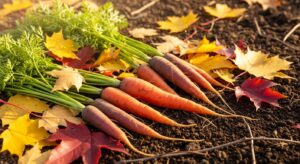
Carrots are one of the easiest and most rewarding vegetables for fall gardens.
They actually develop a sweeter flavor when grown in cooler weather, as the plant converts starches into natural sugars to protect itself from frost.
Choose varieties like ‘Danvers’ or ‘Napoli’ for autumn planting, and sow seeds directly into loose, well-drained soil about 8–10 weeks before your first expected frost date.
Keep the soil consistently moist during germination, which can take 10–20 days.
As they mature, a layer of mulch will help retain soil warmth, ensuring tender, vibrant carrots well into late fall.
2. Spinach
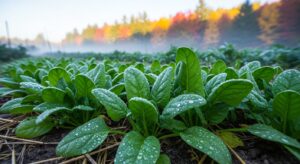
Spinach thrives in chilly conditions and can even survive through light frosts, making it a top choice for a fall vegetable garden.
Its rich green leaves are packed with vitamins A, C, and K, offering a healthy boost to your autumn meals.
Sow seeds directly in the ground about 6–8 weeks before the first frost, spacing them to allow airflow and reduce disease risk.
For continuous harvests, plant new seeds every two weeks until the weather turns too cold.
Spinach leaves become sweeter after a frost, making them perfect for fresh salads or sautéed side dishes.
3. Broccoli
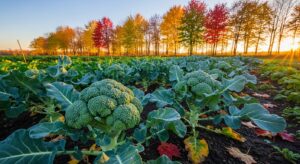
Broccoli loves the cool, consistent temperatures of fall, which help it produce tight, flavorful heads without bolting.
Start seeds indoors in midsummer or purchase seedlings to transplant outdoors in late summer.
Give each plant plenty of space, as broccoli needs good airflow to prevent fungal diseases.
Harvest the main head when the buds are still tight and deep green, then enjoy smaller side shoots that continue growing for weeks.
A little frost actually enhances the taste, giving your broccoli a sweeter, more robust flavor.
4. Beets
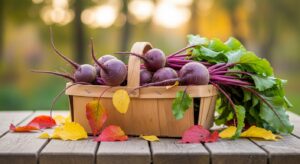
Beets are a double-duty fall vegetable—you can enjoy both the earthy, tender roots and the nutrient-rich leafy greens.
They grow quickly, maturing in about 50–70 days, which means you can plant them in late summer for a perfect fall harvest.
Sow seeds directly in well-loosened soil, thinning seedlings to allow enough room for bulb development.
Beets tolerate cooler weather well and can even handle a light frost without damage. Roast them for a caramelized side dish, pickle them for later, or sauté the greens for a quick, healthy addition to meals.
5. Lettuce
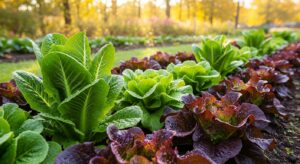
Lettuce is one of the most versatile fall vegetables because it grows quickly and comes in many varieties, from crisp romaine to tender butterhead.
Cooler weather prevents lettuce from bolting, so you can enjoy fresh, flavorful leaves for weeks.
Plant seeds directly into the soil every 2–3 weeks to ensure a steady supply until the first hard frost.
Lettuce thrives in partial sunlight during fall, and a lightweight row cover can protect it from early cold snaps.
Harvest outer leaves as needed, allowing the inner leaves to keep growing.
6. Radishes
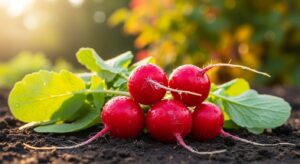
Radishes are the speed champions of the fall garden, with some varieties ready to harvest in just 20–30 days.
Their peppery bite adds excitement to salads and roasted vegetable dishes.
Plant radish seeds directly in the garden in well-drained soil, spacing them an inch apart.
Because they grow so quickly, you can sow multiple rounds for continuous harvests until frost sets in.
Cooler weather helps radishes maintain a crisp texture and reduces the risk of them becoming woody or overly spicy.
7. Kale
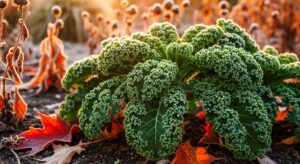
Kale is a powerhouse fall vegetable that actually improves in taste after a frost, as the cold triggers the leaves to develop natural sugars.
It’s also incredibly hardy—some varieties can survive well into winter in milder climates.
Plant kale in late summer so it has time to establish strong roots before the cold sets in.
Space plants generously and mulch around the base to retain soil warmth and moisture.
Whether you enjoy it fresh in salads, cooked in soups, or baked into crispy chips, kale will keep your fall garden producing for months.
🛠 Preparing Your Garden for Fall Planting
To make your fall garden vegetables idea a reality, follow these steps:
-
Clear Summer Crops: Remove any spent plants to prevent disease.
-
Enrich the Soil: Add compost or organic matter for nutrient-rich beds.
-
Plan for Frost: Use row covers or cold frames to extend the season.
-
Stagger Planting: Plant seeds every couple of weeks for continuous harvests.
🌾 Tips for a Successful Fall Harvest
-
Know Your First Frost Date: Count backwards to determine planting time.
-
Choose Cold-Tolerant Varieties: Look for labels like “frost hardy” or “cool season.”
-
Mulch Generously: Helps retain soil warmth and moisture.
-
Water Consistently: Even in cooler weather, plants need regular moisture.
🍽 Enjoying Your Fall Bounty
Once harvested, your fall vegetables can be enjoyed in hearty soups, roasted dinners, and fresh salads.
The crisp air and rich flavors make autumn produce truly special.
By planning ahead and using the right fall garden vegetables idea, you can transform your backyard into a cold-weather oasis of nutrition and taste.
✅ Final Thought:
Don’t let your garden sit idle after summer. With the right planning and the perfect fall garden vegetables, you can keep your harvests going strong until the first snow.
The key is to work with the season, not against it—embracing crops that thrive in cool weather and reward you with flavor-packed produce.
❓ Frequently Asked Questions — Fall Garden Vegetables Idea
1. What vegetables grow best in a fall garden?
Cool-weather crops like carrots, spinach, broccoli, beets, lettuce, radishes, and kale thrive in fall’s cooler temperatures.
2. When should I start planting my fall vegetables?
Count backwards from your area’s first expected frost date. Most fall vegetables should be planted 6–10 weeks before frost.
3. Can I plant fall vegetables in pots or containers?
Yes! Many fall vegetables, such as lettuce, spinach, and radishes, grow well in containers as long as they have good drainage.
4. Do fall vegetables need as much sunlight as summer crops?
Most still need at least 6 hours of sunlight per day, but they can tolerate partial shade better than heat-loving plants.
5. Will frost kill my fall vegetables?
Some, like lettuce and radishes, can be damaged by a hard frost, but others, such as kale and carrots, actually taste sweeter afterward.
6. How can I extend my fall growing season?
Use row covers, cold frames, or mulch to protect plants from frost and keep the soil warmer for longer.
7. Do I need to fertilize fall vegetables?
Yes—adding compost or a balanced organic fertilizer at planting time will help ensure healthy growth in cooler weather.
8. Can I grow fall vegetables from seed or should I buy seedlings?
Both work. Fast-growing crops like radishes are best from seed, while slower crops like broccoli often benefit from starting as seedlings.
9. How often should I water my fall garden?
Even in cooler weather, vegetables need consistent moisture—about 1 inch of water per week, either from rain or irrigation.
10. What’s the easiest fall vegetable for beginners?
Radishes are the easiest due to their quick growth, low maintenance needs, and ability to thrive in cool weather.